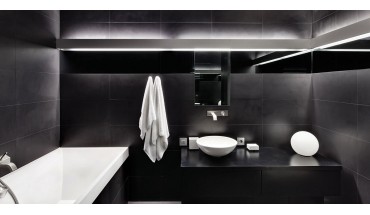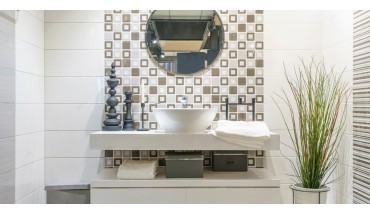
GROHE has a rich tradition of creating market-leading products. GROHE has expanded its core competencies by acquiring the skills and experience of innovative enterprises. Each new acquisition has made a new know-how incorporated in the portfolio. The best example is Carl Nestler: founded in 1873, the company had already earned a reputation as a faucet-maker in the early years and developed the new thermostat technology with advanced optimizations. The company has been part of GROHE since 1956 and to this day the thermostats still remain an important part of the GROHE product portfolio. They influence the corporate DNA of GROHE. Time after time, more pioneering companies have been brought into the GROHE Group to strengthen the business as part of our drive to offer consumers the latest and best technology.
1936 – FOUNDING YEAR OF GROHE
Friedrich Grohe buys Berkenhoff & Paschedag in 1936. Later in 1948 Berkenhoff & Paschedag is renamed to Friedrich Grohe.
1948 – FRIEDRICH GROHE
1948, the company is renamed after its owner, Friedrich Grohe Armaturenfabrik.
In 1983, the company's products were exclusively distributed in the Middle East, the East Mediterranean as well as North and West Africa by Grome Marketing. Later in 1993, Grohe acquired 50% of Grome, resulting in a joint venture between Mesma Holdings Ltd. and Grohe AG.
The 1990s and 2000s: involvement of investors
In 1991, the company bought two other producers of faucets: Herzberger Armaturen GmbH from the Brandenburg region and Armaturenfabrik H. D. Eichelberg & Co. GmbH at Iserlohn in Westphalia. Grohe was also restructured as a public limited company. By taking over the DAL group in 1994, the company acquired a production site in Porta Westfalica, Westphalia; at the same time, the company also acquired Tempress Ltd. of Mississauga in Ontario (Canada). At the Hemer site, new technology and factory control facilities were opened; in 1996 saw the company expand to Portugal and Thailand. A new design center followed at the Hemer site in 1997.
In 1998, a group of investors working with BC Partners bought all available Grohe shares and delisted the company in the following year, making the Grohe Holding GmbH company, owned by BC partners, into the majority owner of Grohe AG in 1999. BC partners sold the company to a consortium of investors from the Texas Pacific Group and CSFB Private Equity (a subsidiary of the Swiss Credit Suisse banking group) five years later in 2004.
In 2005, Franz Müntefering, chairman of the then ruling German Social Democratic Party (SPD), sparked a debate on capitalism by designating foreign private equity firms as "locusts". He made TPG-owned Grohe his main example. The "locust" metaphor remained popular in German politics and media for years while the German government cited Grohe as an example for a successful turnaround only three years later.
The company’s sales and profit figures had been stagnating for years, leading to a programme of savings as of 2005. Around 500 production jobs were cut at sites in Germany and the Herzberg factory was closed; the sites in Thailand and Portugal were expanded considerably. Through 2008, investments totaling 130 million euros were made in Germany in the area of production technology and logistics.
2010-present: recent history
Grohe is currently Europe’s biggest manufacturer of sanitary fittings and has eight percent of the worldwide market.[5] The German market makes up roughly 15 percent of overall sales. Currently, Grohe AG is owned almost 100% by Grohe Holding GmbH (there are still some minority shareholders from the period in which Grohe AG was listed on the stock market). Grohe Holding GmbH is owned by investors.
In June 2010, the company saw a ruling against the European sanitary fittings industry by the European Commission. The Commission found that European manufacturers had operated a cartel between 1992 and 2002 and imposed a collective fine of 622 million euros. Grohe's share of the fine amounted to 54.8 million euros. The current Grohe board of directors, which took up business after the period under investigation, introduced awareness programmes about competition law and operates a zero-tolerance policy towards price-fixing.
In early 2011, Grohe acquired a majority stake in the leading Chinese sanitary fittings producer Joyou, making a successful public takeover bid. The aim of this takeover is above all to strengthen Grohe’s sales infrastructure on the fast-growing Asian market.Grohe currently holds a 72 percent stake in Joyou.
In 2012, Grohe AG's revenues increased by 21 percent to 1,405 million euros; operating profits improved by 18 percent to reach 273 million euros, representing a return on revenue of 19.4 percent.
In May 2013, David Haines, chairman of Grohe, confirmed that, although the company is examining all options for ending investor involvement, no concrete plans had yet been made. Capital market experts estimate that Grohe would currently be valued at up to four billion euros if it were to return to the stock market.
In September 2013, it was announced that Grohe had received the largest ever investment from a Japanese company in Germany. The firm is now almost entirely owned by the Japanese building materials company Lixil and Development Bank of Japan, after a €3 billion deal for 87.5 percent of the firm.
Grohe was taken over by Lixil Group and the Development Bank of Japan in January 2014.
In February 2017, the company's revenues accounted for 965 million euros during the first nine months of the fiscal year. Grohe claimed their solid growth is based on their international market shares with Grohe products available in 150 countries as well as increasing sales in Germany.
In May 2017, Grohe announced the takeover of the former joint venture Grome.
In September 2017, Grohe has listed in the Change the World ranking of the business magazine Fortune as one of 50 international companies whose strategy have a positive impact on society.

















